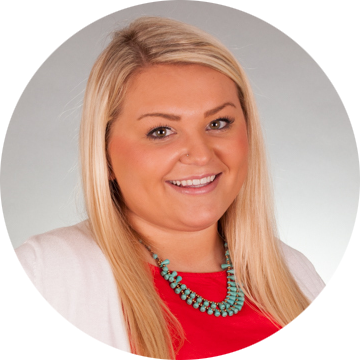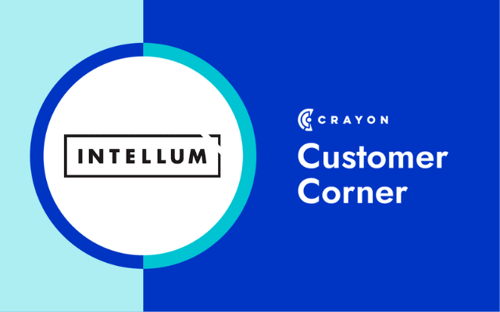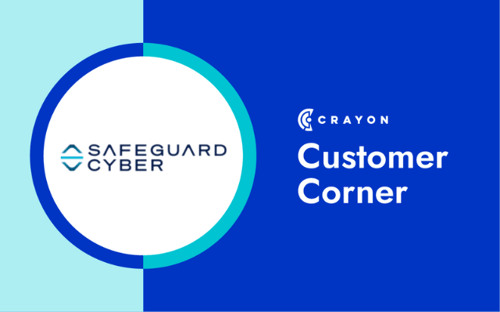Crayon's Product Marketing Spotlight is a video interview series where we chat with product marketers to get a glimpse into their careers and gain unique insight into product marketing strategy. In this edition of the Product Marketing Spotlight Series, we shine the light on Alison Hayter of Loopio.
Video interview transcription:
MC: Hi, my name is Mackenzie Colcord and I'm the host of Crayon's Product Marketing Spotlight Series. Today, I have joining me, Alison Hayter. She's the Director of Product Marketing at Loopio. Thanks again for being here, Alison, and I'm super excited to get to chat with you today.
AH: Thanks so much for having me, Mackenzie. This is fun. I'm looking forward to it.
MC: Of course. Yeah, so just to kick it off, I'd love to learn a bit more about your company and your career path as well.
AH: Yeah, so Loopio, we're a B2B SaaS company located in Toronto, Canada, and our software is essentially all about the problem of helping companies respond to RFPs, security questionnaires, different types of questionnaires that come up in that buying cycle as part of the evaluation and purchase process. If anyone listening has ever been part of that process, it can be really, really painful. There are sometimes hundreds of questions. It takes a long time. It's not usually people's favorite part of their job. For some people, it's their whole job and it can be really challenging, and so we make it a little less challenging. We automate a lot of the manual parts of the process, we centralize a lot of the content that's required to participate in those responses, and it's honestly a company I really love for all kinds of reasons, but one of the things, as a product marketer, is that it's a solution that has just amazing product market fit, and that always gets me excited. So great company to be a part of.
MC: Yeah, absolutely. And just on a personal level, what led you over to Loopio?
AH: Yeah, so I'm Loopio's director of product marketing. I've been there for a little bit under two years now, and I've honestly spent the last approximately 10 years in pretty specifically B2B SaaS companies in product marketing. Totally stumbled into product marketing by accident nearly 10 years ago. It was not the very present, obvious part of marketing that it is today. It was a much newer discipline at the time. And I was a marketing assistant at another B2B SaaS company, heard we were thinking of hiring our first product marketer through the rumor mill, and got my nerve up to invite my VP of marketing to a meeting and make my pitch for why I wanted to be that person. And had no clue what I was getting myself into, but 10 years later, still really, really enjoying it.
MC: Awesome. Yeah, I love that initiative.
AH: You got to go after things, and sometimes you have no clue what you're getting yourself into, but sometimes it works out great.
MC: Yeah, exactly. So for product marketers who may be earlier on in their careers right now and are really just looking to grow their skills, do you have any advice for them?
AH: So much advice. Probably a lot of advice that I didn't start taking until even more recently. And also, again, because the landscape has changed so much in such exciting ways over the last couple of years, absolutely encourage folks to get involved in communities like the Product Marketing Alliance. I will not be the first person to say that. But LinkedIn has also become a really exciting place for product marketers to share little tips and tricks, things they're working on. If you follow the right people, if you look at Crayon Spotlight Series, I'm sure, and look at people who have been involved here, or people who have been guests on podcasts. PMA puts together a top influencers list.
AH: If you just connect with or follow those people on LinkedIn, you'll get exposed to all kinds of amazing nuggets. And then, I've tried to take that a step further myself this past year. I've been finding so much value from those kinds of asynchronous conversations on LinkedIn and in the PMA community. I started reaching out to folks more, especially folks who were involved in really interesting conversations, booking more Zoom coffee chats, now that we live in a world where Zoom coffee chat are a thing and it's so easy to connect with people all across the world. So I reach out to a lot of B2B SaaS folks and have a lot of really interesting conversations, and folks who are really generous with their knowledge and talking about what they're working on. I've learned a ton that way as well.
MC: Yeah, I think regardless of the role, networking is so important.
AH: I'll say too, for folks who might feel like if they're newer in their careers and they're feeling a little anxious about reaching out to folks who are more senior, it's a very competitive job market right now. And I actually, I make time. I try to spend time talking to folks who are maybe at my level, maybe a little bit beyond, but also folks who are earlier in their career, because it's helpful for me as I'm thinking of hiring, to know some great folks who are building their career. So don't hesitate to reach out to anyone on LinkedIn, I feel like. Cold outreach, it works sometimes.
MC: It's a great tool. So switching gears here over to competitive intelligence, I know for product marketers, that's a super important role. Do you have any tips for product marketers on how to get competitive intelligence buy-in company-wide, and getting everyone on the same page with that?
AH: Yeah, so lots of tips. I think it's funny; competitive intelligence is one of the many, many cross-departmental roles or programs that product marketing is often responsible for, and so a lot of the tools and the tips that apply to competitive intelligence, apply to all kinds of different programs that might be cross-functional. Truly, I think it's about making sure that you're not trying to go it alone. Sometimes, folks can spend a lot of time... I know this is something I've done in my past... spend a lot of time in my own head, trying to put things together that are really great and then bring it out to the rest of the company and say, "Here it is. I've done it. What do you think? Please use it." And that's probably the easiest and worst mistake to make.
AH: I think that when you build things with people and you bring more people in earlier on, I've found that that just makes a huge difference in A, the quality and the strength of the actual material. If you're bringing in sales and they're having those conversations, you're bringing in your CS team who is speaking with customers regularly, you're going to get a whole wealth of information that you wouldn't have had access to otherwise. So just bringing more people in early, huge, huge thing. And then, frankly, because those people were involved early, they're usually a lot more willing and likely to champion that material and that enablement work in the future, in the conversations that they have with their direct reports or just across the organization.
AH: Best thing you can do is get one of your top performing sales people really ingrained in some of your processes and giving you early-on feedback, so that then, you can name drop when you release new things and you say, "Oh, so and so was involved in this and has given it her stamp of approval." It's always really nice to have that validation from the market phasing teams. So those are a few ideas that initially come to mind, but truly, I don't think there's a one-size-fits-all. I think the big thing is that product marketing cannot do it alone.
MC: Yeah, absolutely. Kind of sounds like the overarching theme is really just building a culture of competitive intelligence within an organization.
AH: Yeah. I know Slack is great for that, right? We absolutely have... We have a competitive intelligence channel where we have a bit of a rule of, see something, say something.
MC: Right.
AH: One thing that product marketing actually does is, we get to run an onboarding session with a lot of new hires that comes through the door, and so every new person that comes through, we talk to them about that competitive intelligence channel. We tell them that we have a philosophy of, if you see something, say something. Everyone is welcome to post in that channel. We encourage it. We want to have these conversations. So they hear that right from the beginning, and that definitely helps to keep that culture alive.
MC: Yeah, absolutely. And I think another or important point with that is that, this intel is being pushed somewhere where people live every day. People are already in Slack, so when the intel is there, that's that extra push for them to open the message, or contribute, or get involved in some way.
AH: Yeah, absolutely. I think it's always great to have a one true source or two true sources, but at least very, very clear and frequently communicated places to go to find that kind of information. We also have a win/loss program that helps support our competitive intelligence work, and we always make sure to post summaries and the key highlights within our competitive intel channel, because we know that folks aren't otherwise necessarily going to stumble across that win/loss information.
MC: Yeah, absolutely. So obviously, CI sometimes can be a challenge to get buy-in company-wide, but also another challenge for a lot of product marketers is KPIs. Just curious, from your perspective, what KPIs are you focusing on right now?
AH: Yeah, so we at Loopio, we rally around OKRs, but I will say, they're both acronyms close enough for the purposes of this conversation. I think I'm fine to talk about my OKRs. First, as a company, we go through a process annually of refreshing our OKRs, so I think that's really important, is that I don't feel like product marketing should ever have set it and forget it KPIs or OKRs. And I very much believe that product marketing's KPIs in particular really need to be aligned to the actual overarching business's KPIs. And so we, honestly at Loopio, try to model ours very, very closely. So as a company, for instance, one of our KPIs that we have is win rate, and we have an overarching win rate metric that we're looking at, at the company-wide level, but at the product marketing level, we've broken that down by very specific segments that we're looking at and very specific competitors we're looking at. We know where we're at right now, and we look at a 90-day trailing number of what our win rate is looking like.
AH: We work with RevOps to get the visibility there, and we make sure that the work that we're doing is directly related to that. If we didn't have a reason to be focused on win rate, if the company wasn't focused on win rate, that wouldn't be our core KPI, but it is, because the company is focused on it, and we believe we can meaningfully move it forward, especially in the areas we've identified. We're then able to create campaigns that very much ladder up to those KPIs to show that that's what we're moving. And then, another one we have as we look at ARPA, average revenue per account, so we're trying to increase that all of the time, and we've got some very specific initiatives that we're focused on. For instance, from an expansion perspective with current business, we're trying to get folks to upgrade from one plan to another plan, and then that's a lot of the work that we do with our CS team and our product team.
MC: That's awesome. I'm sure that'll be super helpful for product marketers listening in, trying to build up their programs. That's some great advice.
AH: Yeah, I think it can and should be different at every company, right? And depending on what that company's goals are at that point in time in their journey.
MC: Absolutely. And for my last question for you today, this is a very Crayon-themed question. What does it mean to you to compete like you mean it?
AH: Yeah, I think honestly, in order to compete like you mean it, you need to realize that competitive intelligence is a team sport. We talked about that part before, of the just getting the program off the ground, bringing people in, bringing their insights in, but the other really important piece of that, that I talk about with my team all the time is, another easy-to-make mistake with competitive intelligence or market intelligence in general, if you're building out personas and things like that, you can end up in a situation where you make yourself a lot smarter, but you don't make the rest of the company smarter, because you haven't brought it fully to life by really distributing it, and communicating it, and over communicating it, and making it a part of the company's lifeblood and the work that we're doing on an ongoing basis.
AH: So we do fun things like, we have a hashtag based around very specific campaigns, and it's a fun hashtag, and it's all about us trying to beat the competition and stuff, and people rally around that. And we have weekly company meetings where different parts of the business give updates. We give really fun updates using our hashtag, using memes and gifs to make it engaging and to get people to really feel connected to the goal that we're trying to achieve, because it's not just our goal. I think that if you think that any one department owns competitive intelligence, that's probably an immediate red flag. Everyone at the company owns competitive intelligence. It is a team sport, and so everybody needs to be in it together.
MC: I love that. I completely agree with that. It 100% is a team sport. Well, thank you again for your time today, Alison. It was a pleasure speaking with you. And there's lots of great nuggets of information that I know product marketers can gain a lot of value from. So thank you again.
AH: No, thanks so much for having me. This was fun.

Related Blog Posts
Popular Posts
-
 The 8 Free Market Research Tools and Resources You Need to Know
The 8 Free Market Research Tools and Resources You Need to Know
-
 How to Measure Product Launch Success: 12 KPIs You Should Be Tracking
How to Measure Product Launch Success: 12 KPIs You Should Be Tracking
-
 24 Questions to Consider for Your Next SWOT Analysis
24 Questions to Consider for Your Next SWOT Analysis
-
 How to Create a Competitive Matrix (Step-by-Step Guide With Examples + Free Templates)
How to Create a Competitive Matrix (Step-by-Step Guide With Examples + Free Templates)
-
 6 Competitive Advantage Examples From the Real World
6 Competitive Advantage Examples From the Real World





